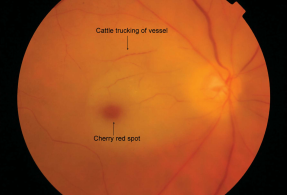Sudden blockage of the central retinal artery leading to ischaemia of the inner retina
Ophthalmologic emergency
May be transient - Amaurosis fugax - treated like Transient Ischemic Attack
Causes/Factors
Anything that increases the risk of embolic events or CVD
- Embolic events - theromboemboli from the carotid artery or heart can occlude the vessel
- Atherosclerosis - buld-up of plaque in the carotid artery or ophthalmic artery
- Vasculitis - inflammatory conditions such as Giant cell arteritis
- Hypercoagulable states - Antiphospholipid syndrome or protein C/S defiency
Clinical Features
- Sudden vision loss
- Painless
- Central sctoma
- Pale and opaque retina - due to oedema
- Relative afferent pupillary defect -
Investigations
Opthalmic examination
-
Cherry-red spot - characteristic finding due to contrast between pale retina and intact choroid

-
Retinal arteries are irregular and appear as red threads
Causes of event
- Carotid doppler USS - look for stenosis or plaque in carotids
- Echocardiography - cardiac sources of emboli
- Blood tests - FBC, high ESR is suggestive of inflammatory cause
Management
Sudden loss of vision is an ophthalmological emergency and requires immediate referral to the eye emergency department.
- (Ocular massage - digital massage may dislodge the emboli)
- High dose Aspirin - 300mg
- Intraocular pressure lowering - topical medications or anterior chamber paracentesis
- IV acetazolamide
Complications/red Flags
- Permanent vision loss
- Contralateral eye involvement - increased risk of contralateral CRAO
- Systemic embolic events - can be a manifestation of systemic embolic disease warranting further evaluation for Stroke or myocardial infarction